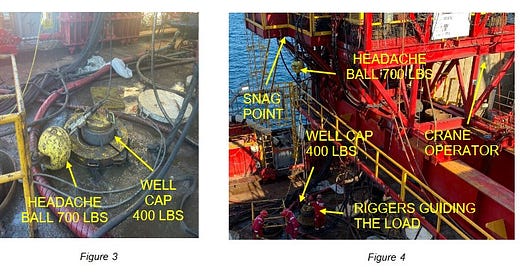BSEE Safety Alert No. 460. Overhaul Ball Crashes to Deck Resulting in High Potential, Near-Miss Fatality.
Remove the People; Trust Your Instruments
The Bureau of Safety and Environmental Enforcement (BSEE) has issued Safety Alert No. 460. Overhaul Ball Crashes to Deck Resulting in High Potential, Near-Miss Fatality.
There are many lessons to be learned from this frightening event. In the report, BSEE has nine recommendations, all of which need to carefully studied and evaluated.
Remove the People
One of the BSEE recommendations reads as follows,
Discuss what key controls are in place to remove yourself and your team members from the potential “line of fire” (i.e., The zone within a work area where there is a risk of (serious) injury from machinery or equipment).
This recommendation makes sense in context. But it can be generalized.
Yesterday we reviewed another serious incident report, this one from the Center from Chemical Process Safety. The incident resulted in fatalities and injuries to people who did not need to be present (my emphasis). We noted that the best way of ensuring that no one gets hurt is to remove people from the hazardous area (“If a man’s not there, he can’t be killed”).
The same lesson seems to apply to this “dropped ball” incident. There is nothing in the report that suggests that the workers involved needed to be so close to the crane lift. It seems as if they could have stood further away. Had they done so, the “near-miss” aspect of the event would not be so relevant.
Trust Your Instruments
Instrumentation and electronic devices in general should be trusted. Of course, they can fail to operate or give a false signal. But the first assumption should be that they are telling the truth. (I once worked on the start-up of a world-scale chemical plant. We had an on-going production problem that we could not resolve for many weeks. In the end, it turned out that one of the instruments had been providing information that told us the cause of the problem. But “everyone knew” that that instrument was not to be trusted, so we ignored it.)
With regard to this event, the persons involved in the event could reasonably have asked why the load cell’s signal was not changing, even though the well cap was, apparently, being lowered. In other words, the instrument was telling the truth, but its message was unusual, so it was ignored.
Credit to BSEE and the CCPS
The Bureau of Safety and Environmental Enforcement and the Center for Chemical Process Safety are to be complimented on the frequency and quality of their Safety Alerts and Beacons. Ditto for the Chemical Safety Board.
The information and insights that they provide are invaluable. But their recommendations are, in my view, often too incident-specific. The events that they describe and evaluate can often provide more general insights.





